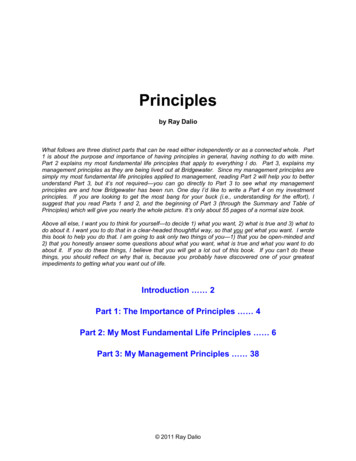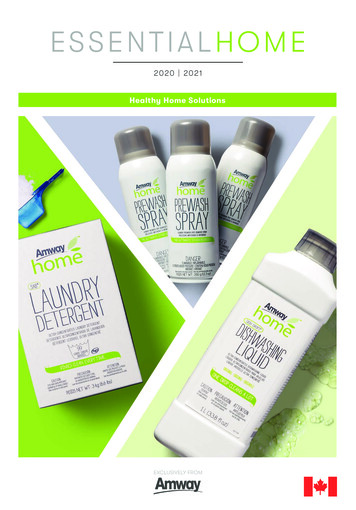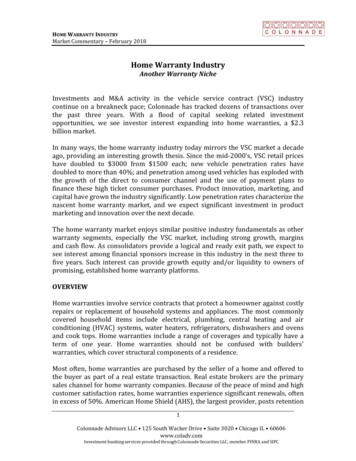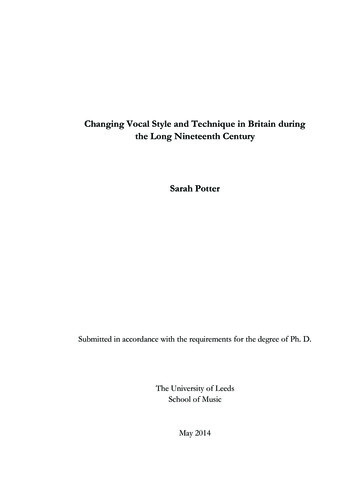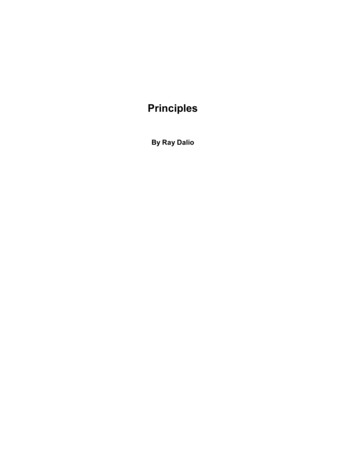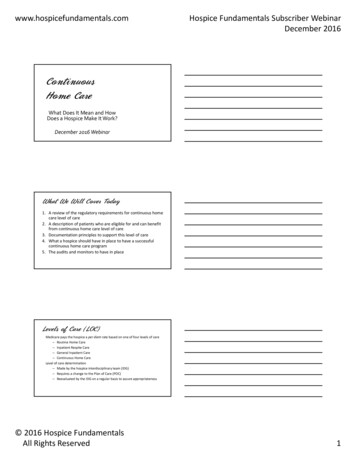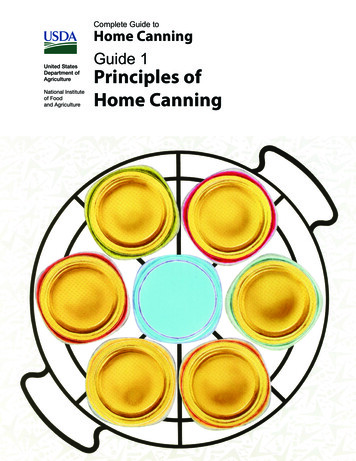
Transcription
Complete Guide toHome CanningGuide 1Principles ofHome Canning
1-2
Guide 11Table of ContentsPrinciples of Home CanningPrinciples of Home CanningSection . PageWhy can foods?.1-5How canning preserves foods.1-5Ensuring safe canned foods.1-6Food acidity and processing methods.1-8Process adjustments at high altitudes. 1-10Equipment and methods not recommended. 1-10Ensuring high-quality canned foods. 1-11Maintaining color and flavor in canned food. 1-11Advantages of hot packing. 1-12Controlling headspace. 1-13Jars and lids. 1-13Jar cleaning and preparation. 1-14Sterilization of empty jars. 1-14Lid selection, preparation, and use. 1-15Recommended canners . 1-17Boiling-water canners . 1-18Using boiling-water canners . 1-18Pressure canners . 1-19Using pressure canners. 1-21Selecting the correct processing time . 1-22Example of using tables for determining proper process time. 1-23Cooling jars. 1-25Testing jar seals. 1-25Reprocessing unsealed jars. 1-26Storing canned food. 1-26Identifying and handling spoiled canned food. 1-26Preparing pickled and fermented foods. 1-27Ingredients. 1-28Pickles with reduced salt content. 1-28Firming agents. 1-28Preventing spoilage. 1-29Preparing butters, jams, jellies, and marmalades. 1-29Ingredients. 1-29Jams and jellies with reduced sugar. 1-30Preventing spoilage. 1-30Methods of making jams and jellies. 1-30Canned foods for special diets. 1-31Canning without sugar. 1-31Canning without salt (reduced sodium). 1-31Canning fruit-based baby foods. 1-31How much should you can?. 1-32Glossary of Terms. 1-33Index of Foods. 1-361-3
1-4
Why can foods?Many vegetables begin losing some of their vitamins when harvested. Nearly half the vitaminsmay be lost within a few days unless the fresh produce is cooled or preserved. Within 1 to 2weeks, even refrigerated produce loses half or more of some of its vitamins. The heating processduring canning destroys from one-third to one-half of vitamins A and C, thiamin, and riboflavin.Once canned, additional losses of these sensitive vitamins are from 5 to 20 percent each year.The amounts of other vitamins, however, are only slightly lower in canned compared with freshfood. If vegetables are handled properly and canned promptly after harvest, they can be morenutritious than fresh produce sold in local stores.1Principles of Home CanningCanning can be a safe and economical way to preserve quality food at home. Disregarding thevalue of your labor, canning homegrown food may save you half the cost of buyingcommercially canned food. Canning favorite and special products to be enjoyed by family andfriends is a fulfilling experience and a source of pride for many people.The advantages of home canning are lost when you start with poor quality fresh foods; whenjars fail to seal properly; when food spoils; and when flavors, texture, color, and nutrientsdeteriorate during prolonged storage.The information and guides that follow explain many of these problems and recommend waysto minimize them.How canning preserves foodsThe high percentage of water in most fresh foods makes them very perishable. They spoil orlose their quality for several reasons: growth of undesirable microorganisms—bacteria, molds, and yeasts, activity of food enzymes, reactions with oxygen, moisture loss.Microorganisms live and multiply quickly on the surfaces of fresh food and on the inside ofbruised, insect-damaged, and diseased food. Oxygen and enzymes are present throughoutfresh food tissues.Proper canning practices include: carefully selecting and washing fresh food, peeling some fresh foods, hot packing many foods, adding acids (lemon juice or vinegar) to some foods, using acceptable jars and self-sealing lids, processing jars in a boiling-water or pressure canner for the correct period of time.Collectively, these practices remove oxygen; destroy enzymes; prevent the growth ofundesirable bacteria, yeasts, and molds; and help form a high vacuum in jars. Good vacuumsform tight seals which keep liquid in and air and microorganisms out.1-5
Ensuring safe canned foodsGrowth of the bacterium Clostridium botulinum in canned food may cause botulism—a deadlyform of food poisoning. These bacteria exist either as spores or as vegetative cells. The spores,which are comparable to plant seeds, can survive harmlessly in soil and water for many years.When ideal conditions exist for growth, the spores produce vegetative cells which multiplyrapidly and may produce a deadly toxin within 3 to 4 days of growth in an environmentconsisting of: a moist, low-acid food a temperature between 40 and 120 F less than 2 percent oxygen.Botulinum spores are on most fresh food surfaces. Because they grow only in the absence of air,they are harmless on fresh foods.Most bacteria, yeasts, and molds are difficult to remove from food surfaces. Washing fresh foodreduces their numbers only slightly. Peeling root crops, underground stem crops, and tomatoesreduces their numbers greatly. Blanching also helps, but the vital controls are the method ofcanning and making sure the recommended research-based process times, found in theseguides, are used.The processing times in these guides ensure destruction of the largest expected number of heatresistant microorganisms in home-canned foods. Properly sterilized canned food will be free ofspoilage if lids seal and jars are stored below 95 F. Storing jars at 50 to 70 Fenhances retention of quality.1-6
1Principles of Home Canning1-7
Food acidity and processing methodsWhether food should be processed in a pressure canner or boiling-water canner to controlbotulinum bacteria depends on the acidity of the food. Acidity may be natural, as in most fruits,or added, as in pickled food. Low-acid canned foods are not acidic enough to prevent the growthof these bacteria. Acid foods contain enough acid to block their growth, or destroy them morerapidly when heated. The term “pH” is a measure of acidity; the lower its value, the more acid thefood. The acidity level in foods can be increased by adding lemon juice, citric acid, or vinegar.Low-acid foods have pH values higher than 4.6. They include red meats, seafood, poultry, milk,and all fresh vegetables except for most tomatoes. Most mixtures of low-acid and acid foods alsohave pH values above 4.6 unless their recipes include enough lemon juice, citric acid, or vinegarto make them acid foods. Acid foods have a pH of 4.6 or lower. They include fruits, pickles,sauerkraut, jams, jellies, marmalades, and fruit butters.Although tomatoes usually are considered an acid food, some are now known to have pH valuesslightly above 4.6. Figs also have pH values slightly above 4.6. Therefore, if they are to be cannedas acid foods, these products must be acidified to a pH of 4.6 or lower with lemon juice or citricacid. Properly acidified tomatoes and figs are acid foods and can be safely processed in aboiling-water canner.Botulinum spores are very hard to destroy at boiling-water temperatures; the higher the cannertemperature, the more easily they are destroyed. Therefore, all low-acid foods should be sterilizedat temperatures of 240 to 250 F, attainable with pressure canners operated at 10 to 15 PSIG. PSIGmeans pounds per square inch of pressure as measured by gauge. The more familiar “PSI” designation is used hereafter in this publication. At temperatures of 240 to 250 F, the time needed todestroy bacteria in low-acid canned food ranges from 20 to 100 minutes. The exact time dependson the kind of food being canned, the way it is packed into jars, and the size of jars. The timeneeded to safely process low-acid foods in a boiling-water canner ranges from 7 to 11 hours; thetime needed to process acid foods in boiling water varies from 5 to 85 minutes.1-8
1Principles of Home Canning1-9
Process adjustments at high altitudesUsing the process time for canning food at sea level may result in spoilage if you live at altitudesof 1,000 feet or more. Water boils at lower temperatures as altitude increases. Lower boilingtemperatures are less effective for killing bacteria. Increasing the process time or canner pressure compensates for lower boiling temperatures. Therefore, when you use the guides, select theproper processing time or canner pressure for the altitude where you live. If you do not know thealtitude, contact your local county Extension agent. An alternative source of information would bethe local district conservationist with the Soil Conservation Service.Equipment and methods not recommendedOpen-kettle canning and the processing of freshly filled jars in conventional ovens, microwaveovens, and dishwashers are not recommended, because these practices do not prevent all risksof spoilage. Steam canners are not currently recommended because processing times for use withcurrent models are still being researched. It is not recommended that pressure processes in excessof 15 PSI be applied when using new pressure canning equipment. So-called canning powders areuseless as preservatives and do not replace the need for proper heat processing. Jars with wirebails and glass caps make attractive antiques or storage containers for dry food ingredients butare not recommended for use in canning. Neither one-piece zinc porcelain-lined caps nor zinccaps that use flat rubber rings for sealing jars are recommended any longer.1-10
Ensuring high-quality canned foodsCan fruits and vegetables picked from your garden or purchased from nearby producers whenthe products are at their peak of quality-within 6 to 12 hours after harvest for most vegetables.For best quality, apricots, nectarines, peaches, pears, and plums should be ripened 1 or moredays between harvest and canning. If you must delay the canning of other fresh produce,keep it in a shady, cool place.Fresh home-slaughtered red meats and poultry should be chilled and canned without delay.Do not can meat from sickly or diseased animals. Ice fish and seafoods after harvest, eviscerateimmediately, and can them within 2 days.1Principles of Home CanningBegin with good-quality fresh foods suitable for canning. Quality varies among varieties of fruitsand vegetables. Many county Extension offices can recommend varieties best suited for canning.Examine food carefully for freshness and wholesomeness. Discard diseased and moldy food. Trimsmall diseased lesions or spots from food.Maintaining color and flavor in canned foodTo maintain good natural color and flavor in stored canned food, you must: Remove oxygen from food tissues and jars, Quickly destroy the food enzymes, Obtain high jar vacuums and airtight jar seals.Follow these guidelines to ensure that your canned foods retain optimum colors and flavorsduring processing and storage: Use only high-quality foods which are at the proper maturity and are free of diseasesand bruises. Use the hot-pack method, especially with acid foods to be processed in boiling water. Don’t unnecessarily expose prepared foods to air. Can them as soon as possible. While preparing a canner load of jars, keep peeled, halved, quartered, sliced, or dicedapples, apricots, nectarines, peaches, and pears in a solution of 3 grams (3,000milligrams) ascorbic acid to 1 gallon of cold water. This procedure is also useful inmaintaining the natural color of mushrooms and potatoes, and for preventingstem-end discoloration in cherries and grapes. You can get ascorbic acid in several forms:Pure powdered form—seasonally available among canners’ supplies in supermarkets.One level teaspoon of pure powder weighs about 3 grams. Use 1 teaspoon per gallonof water as a treatment solution.Vitamin C tablets—economical and available year-round in many stores. Buy 500milligram tablets; crush and dissolve six tablets per gallon of water as a treatmentsolution.Commercially prepared mixes of ascorbic and citric acid—seasonally available amongcanners’ supplies in supermarkets. Sometimes citric acid powder is sold in supermarkets,but it is less effective in controlling discoloration. If you choose to use these products,follow the manufacturer’s directions.1-11
Fill hot foods into jars and adjust headspace as specified in recipes.Tighten screw bands securely, but if you are especially strong, not as tightly as possible.Process and cool jars.Store the jars in a relatively cool, dark place, preferably between 50 and 70 F.Can no more food than you will use within a year.Advantages of hot-packingMany fresh foods contain from 10 percent to more than 30 percent air. How long canned foodretains high quality depends on how much air is removed from food before jars are sealed.Raw-packing is the practice of filling jars tightly with freshly prepared, but unheated food. Suchfoods, especially fruit, will float in the jars. The entrapped air in and around the food may causediscoloration within 2 to 3 months of storage. Raw-packing is more suitable for vegetablesprocessed in a pressure canner.Hot-packing is the practice of heating freshly prepared food to boiling, simmering it 2 to 5minutes, and promptly filling jars loosely with the boiled food. Whether food has been hot-packedor raw-packed, the juice, syrup, or water to be added to the foods should also be heated to boilingbefore adding it to the jars. This practice helps to remove air from food tissues, shrinks food, helpskeep the food from floating in the jars, increases vacuum in sealed jars, and improves shelf life.Preshrinking food permits filling more food into each jar.Hot-packing is the best way to remove air and is the preferred pack style for foods processed ina boiling-water canner. At first, the color of hot-packed foods may appear no better than that ofraw-packed foods, but within a short storage period, both color and flavor of hot-packed foodswill be superior.1-12
Controlling headspace1Principles of Home CanningThe unfilled space above the food in a jar and below its lid is termed headspace. Directionsfor canning specify leaving 1/4-inch for jams and jellies, 1/2-inch for fruits and tomatoes to beprocessed in boiling water, and from 1- to 1-1/4-inches in low acid foods to be processed in apressure canner. This space is needed for expansion of food as jars are processed, and forforming vacuums in cooled jars. The extent of expansion is determined by the air content in thefood and by the processing temperature. Air expands greatly when heated to high temperatures;the higher the temperature, the greater the expansion. Foods expand less than air when heated.Jars and lidsFood may be canned in glass jars or metal containers. Metal containers can be used only once.They require special sealing equipment and are much more costly than jars.Regular and wide-mouth Mason-type, threaded, home-canning jars with self-sealing lids arethe best choice. They are available in 1/2 pint, pint, 1-1/2 pint, quart, and 1/2 gallon sizes. Thestandard jar mouth opening is about 2-3/8 inches. Wide-mouth jars have openings of about3 inches, making them more easily filled and emptied. Half-gallon jars may be used for canningvery acid juices. Regular-mouth decorator jelly jars are available in 8 and 12 ounce sizes. Withcareful use and handling, Mason jars may be reused many times, requiring only new lids eachtime. When jars and lids are used properly, jar seals and vacuums are excellent and jar breakageis rare.1-13
Most commercial pint- and quart-size mayonnaise or salad dressing jars may be used with newtwo-piece lids for canning acid foods. However, you should expect more seal failures and jarbreakage. These jars have a narrower sealing surface and are tempered less than Mason jars, andmay be weakened by repeated contact with metal spoons or knives used in dispensing mayonnaise or salad dressing. Seemingly insignificant scratches in glass may cause cracking and breakage while processing jars in a canner. Mayonnaise-type jars are not recommended for use withfoods to be processed in a pressure canner because of excessive jar breakage. Other commercialjars with mouths that cannot be sealed with two-piece canning lids are not recommended for usein canning any food at home.Jar cleaning and preparationBefore every use, wash empty jars in hot water with detergent and rinse well by hand, or wash ina dishwasher. Unrinsed detergent residues may cause unnatural flavors and colors. Jars shouldbe kept hot until ready to fill with food. Submerge the clean empty jars in enough water to coverthem in a large stockpot or boiling water canner. Bring the water to a simmer (180 F) and keepthe jars in the simmering water until it is time to fill them with food. A dishwasher may be usedfor preheating jars if they are washed and dried on a complete regular cycle. Keep the jars in theclosed dishwasher until needed for filling.These washing and preheating methods do not sterilize jars. Some used jars may have a whitefilm on the exterior surface caused by mineral deposits. This scale or hard-water film on jars iseasily removed by soaking jars several hours in a solution containing 1 cup of vinegar (5 percentacidity) per gallon of water prior to washing and preheating the jars.Sterilization of empty jarsAll jams, jellies, and pickled products processed less than 10 minutes should be filled into sterileempty jars. To sterilize empty jars after washing in detergent and rinsing thoroughly, submerge1-14
Empty jars used for vegetables, meats, and fruits to be processed in a pressure canner need notbe presterilized. It is also unnecessary to presterilize jars for fruits, tomatoes, and pickled orfermented foods that will be processed 10 minutes or longer in a boiling-water canner.Lid selection, preparation, and useThe common self-sealing lid consists of a flat metal lid held in place by a metal screw band duringprocessing. The flat lid is crimped around its bottom edge to form a trough, which is filled with acolored gasket compound. When jars are processed, the lid gasket softens and flows slightly tocover the jar-sealing surface, yet allows air to escape from the jar. The gasket then forms anairtight seal as the jar cools. Gaskets in unused lids work well for at least 5 years from date ofmanufacture. The gasket compound in older unused lids may fail to seal on jars.1Principles of Home Canningthem, right side up, in a boiling-water canner with the rack in the bottom. Fill the canner withenough warm water so it is 1 inch above the tops of the jars. Bring the water to a boil, and boil10 minutes at altitudes of less than 1,000 ft. At higher elevations, boil 1 additional minute foreach additional 1,000 ft elevation. Reduce the heat under the canner, and keep the jars in thehot water until it is time to fill them. Remove and drain hot sterilized jars one at a time, savingthe hot water in the canner for processing filled jars. Fill the sterilized jars with food, add lids,and tighten screw bands.Buy only the quantity of lids you will use in a year. To ensure a good seal, carefully follow themanufacturer’s directions in preparing lids for use. Examine all metal lids carefully. Do not useold, dented, or deformed lids, or lids with gaps or other defects in the sealing gasket.When directions say to fill jars and adjust lids, use the following procedures: After filling jars withfood and adding covering liquid, release air bubbles by inserting a flat plastic (not metal) spatulabetween the food and the jar. Slowly turn the jar and move the spatula up and down to allow airbubbles to escape. (It is not necessary to release air bubbles when filling jams, jellies or all liquidfoods such as juices.) Adjust the headspace and then clean the jar rim (sealing surface) with a1-15
dampened paper towel. Place the preheated lid, gasket down, onto the cleaned jar-sealingsurface. Uncleaned jar-sealing surfaces may cause seal failures. Then fit the metal screw bandover the flat lid. Follow the manufacturer’s guidelines enclosed with or on the box for tighteningthe jar lids properly.Do not retighten lids after processing jars. As jars cool, the contents in the jar contract,pulling the self-sealing lid firmly against the jar to form a high vacuum. If rings are too loose, liquid may escape from jars during processing, and seals may fail. If rings are too tight, air cannot vent during processing, and food will discolor duringstorage. Over tightening also may cause lids to buckle and jars to break, especially withraw-packed, pressure-processed food.Screw bands are not needed on stored jars. They can be removed easily after jars are cooled. Whenremoved, washed, dried, and stored in a dry area, screw bands may be used many times. If left onstored jars, they become difficult to remove, often rust, and may not work properly again.1-16
Recommended canners1Principles of Home CanningEquipment for heat-processing home-canned food is of two main types—boiling water cannersand pressure canners. Most are designed to hold seven quart jars or eight to nine pints. Smallpressure canners hold four-quart jars; some large pressure canners hold 18 pint jars in two layers,but hold only seven quart jars. Pressure saucepans with smaller volume capacities are not recommended for use in canning. Small capacity pressure canners are treated in a similar manner asstandard larger canners, and should be vented using the typical venting procedures.Low-acid foods must be processed in a pressure canner to be free of botulism risks. Althoughpressure canners may also be used for processing acid foods, boiling water canners are recommended for this purpose because they are faster. A pressure canner would require from 55 to100 minutes to process a load of jars; while the total time for processing most acid foods in boilingwater varies from 25 to 60 minutes. A boiling-water canner loaded with filled jars requires about20 to 30 minutes of heating before its water begins to boil. A loaded pressure canner requiresabout 12 to 15 minutes of heating before it begins to vent; another 10 minutes to vent the canner;another 5 minutes to pressurize the canner; another 8 to 10 minutes to process the acid food;and, finally, another 20 to 60 minutes to cool the canner before removing jars.1-17
Boiling-water cannersThese canners are made of aluminum or porcelain-covered steel. They have removable perforatedracks and fitted lids. The canner must be deep enough so that at least 1 inch of briskly boilingwater will be over the tops of jars during processing. Some boiling-water canners do not have flatbottoms. A flat bottom must be used on an electric range. Either a flat or ridged bottom can beused on a gas burner. To ensure uniform processing of all jars with an electric range, the cannershould be no more than 4 inches wider in diameter than the element on which it is heated.Using boiling-water cannersFollow these steps for successful boiling-water canning:1. Before you start preparing your food, fill the canner halfway with clean water. This isapproximately the level needed for a canner load of pint jars. For other sizes andnumbers of jars, the amount of water in the canner will need to be adjusted so it willbe 1 to 2 inches over the top of the filled jars.2. Preheat water to 140 F for raw-packed foods and to 180 F for hot-packed foods.Food preparation can begin while this water is preheating.3. Load filled jars, fitted with lids, into the canner rack and use the handles to lower therack into the water; or fill the canner with the rack in the bottom, one jar at a time,using a jar lifter. When using a jar lifter, make sure it is securely positioned below theneck of the jar (below the screw band of the lid). Keep the jar upright at all times.Tilting the jar could cause food to spill into the sealing area of the lid.4. Add more boiling water, if needed, so the water level is at least 1 inch above jar tops.For process times over 30 minutes, the water level should be at least 2 inches above thetops of the jars.5. Turn heat to its highest position, cover the canner with its lid, and heat until the waterin the canner boils vigorously.6. Set a timer for the total minutes required for processing the food.7. Keep the canner covered and maintain a boil throughout the process schedule. Theheat setting may be lowered a little as long as a complete boil is maintained for theentire process time. If the water stops boiling at any time during the process, bring thewater back to a vigorous boil and begin the timing of the process over, from thebeginning.8. Add more boil
have pH values above 4.6 unless their recipes include enough lemon juice, citric acid, or vinegar to make them acid foods. Acid foods have a pH of 4.6 or lower. They include fruits, pickles, sauerkraut, jams, jellies, marmalades, and fruit butters. Although tomatoes usually are cons

